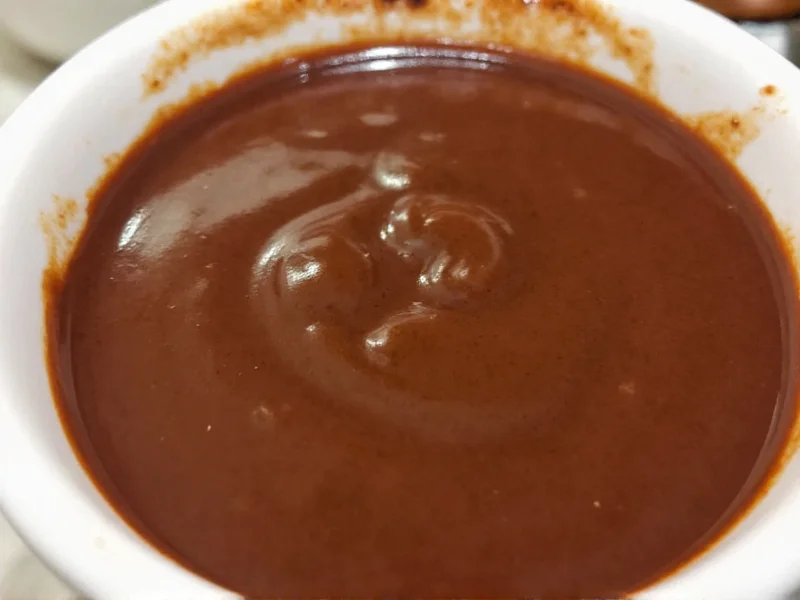Mole represents one of Mexico’s most celebrated culinary treasures, with roots tracing back to pre-Hispanic times. The term “mole” derives from the Nahuatl word “molli,” meaning “sauce” or “sauce made from grinding.” While many people associate mole exclusively with chocolate, this versatile sauce actually encompasses numerous regional variations across Mexico, each with distinctive ingredients and preparation methods.
Understanding Mole: Mexico's Signature Sauce
When exploring what is mexican spicy chocolate sauce called, it’s essential to recognize that “mole” isn’t a single recipe but rather a category of sauces. The most famous chocolate-containing varieties include:
| Mole Variety | Region of Origin | Key Characteristics |
|---|---|---|
| Mole Negro | Oaxaca | Dark color, complex blend of 20+ ingredients including chocolate, chilies, and spices |
| Mole Poblano | Puebla | Slightly sweeter than mole negro, traditionally served with turkey |
| Mole Coloradito | Oaxaca | Reddish hue, moderate heat, contains ancho chilies and少量 chocolate |
| Mole Amarillo | Oaxaca | Yellow color from guajillo chilies, typically no chocolate |
The Chocolate Element in Authentic Mole
Many people searching for what is traditional mexican chocolate sauce called assume all mole contains chocolate, but this isn’t accurate. Only certain varieties incorporate chocolate, and even then, it serves as a subtle flavor enhancer rather than the dominant ingredient. Authentic mole recipes use Mexican chocolate—a rustic, grainy chocolate made with roasted cacao beans, sugar, and cinnamon—not sweetened chocolate bars designed for eating.
The chocolate in mole performs several crucial functions:
- Provides subtle sweetness to balance the heat from chilies
- Creates a smooth, velvety texture
- Helps emulsify the sauce’s diverse ingredients
- Contributes to the sauce’s complex, earthy flavor profile
Key Ingredients Beyond Chocolate
Understanding authentic mole sauce ingredients reveals why this sauce stands apart from simple chocolate sauces. Traditional mole contains:
- Chilies: Ancho, pasilla, mulato, and chipotle provide varying heat levels and flavor notes
- Spices: Cumin, cloves, cinnamon, and black pepper create aromatic complexity
- Nuts and seeds: Sesame seeds, almonds, or peanuts add texture and richness
- Tomatoes or tomatillos: For acidity and brightness
- Garlic and onions: Fundamental flavor base
- Day-old bread or tortillas: For thickening the sauce
The preparation process involves toasting, grinding, and simmering these ingredients over several hours—a testament to why how to make mexican spicy chocolate sauce requires patience and attention to detail.
Historical Significance of Mole
Mole’s origins blend indigenous Mesoamerican and Spanish colonial influences. Pre-Hispanic civilizations like the Aztecs created sauces using ground chilies and seeds, but chocolate was incorporated after the Spanish introduced European cooking techniques and ingredients. The most famous legend attributes mole poblano’s creation to 17th-century nuns at the Santa Rosa convent in Puebla, who supposedly invented the sauce to honor a visiting archbishop.
Despite popular myths, historical evidence suggests mole evolved gradually through cultural exchange rather than a single “eureka” moment. This nuanced history explains why history of mole poblano remains a topic of scholarly discussion among food historians.
Traditional Preparation and Serving Methods
Authentic mole preparation follows time-honored techniques that modern cooks sometimes overlook when searching for traditional mexican mole recipe. The process typically involves:
- Toasting each ingredient separately to enhance flavors
- Grinding ingredients into a smooth paste using a molcajete (mortar and pestle) or metate (stone grinder)
- Simmering the paste in broth for several hours to develop complex flavors
- Serving over poultry (traditionally turkey, though chicken is common today)
Mole holds ceremonial importance in Mexican culture, often served during weddings, holidays, and other significant celebrations. In Oaxaca, seven distinct mole varieties form the foundation of the region’s culinary identity—a tradition recognized by UNESCO as part of humanity’s intangible cultural heritage.
Common Misconceptions About Mole
Several misunderstandings persist about difference between mole and regular chocolate sauce:
- Misconception: Mole is primarily a chocolate sauce
Reality: Chocolate plays a supporting role; chilies and spices dominate the flavor profile - Misconception: All mole contains chocolate
Reality: Many regional varieties (like mole amarillo) contain no chocolate - Misconception: Mole is extremely spicy
Reality: Authentic mole balances heat with sweetness and earthiness; it’s rarely overwhelmingly hot - Misconception: Mole is difficult to make at home
Reality: While traditional preparation is time-consuming, simplified authentic versions are achievable for home cooks
Finding and Enjoying Authentic Mole
For those seeking where to buy genuine mole sauce, consider these options:
- Specialty Mexican markets often carry ready-made mole pastes from Oaxaca
- Reputable online retailers offer authentic mole negro and other varieties
- Some Mexican restaurants sell their house-made mole for takeout
When evaluating commercial mole products, look for ingredients lists featuring multiple chilies, spices, and minimal additives. The best products will specify their region of origin, as types of mexican mole sauces vary significantly by location.











 浙公网安备
33010002000092号
浙公网安备
33010002000092号 浙B2-20120091-4
浙B2-20120091-4